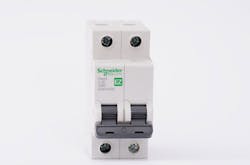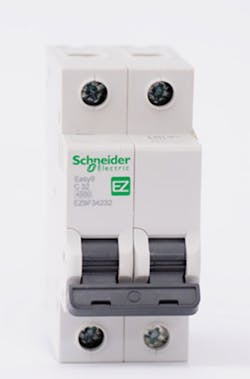With every passing year, more foreign-manufactured electrical equipment is being imported and used in the United States. A lot of this equipment is built to product standards other than what U.S equipment is built to. While there is nothing wrong with equipment built outside of the U.S. product standards, it can present some challenges when used in conjunction with our American National Standards Institute (ANSI) codes and standards equipment.
One issue that has been seen lately is the use of AWG conductors being protected from overcurrent by International Electrotechnical Commission (IEC) rated breakers. For example, a common size of small circuit breaker in the IEC world is a rating of 32A (Photo). So the question becomes, what is the minimum size AWG copper conductor allowed per the National Electrical Code (NEC) for this size breaker?
It seems to be a common misconception that a 10 AWG copper wire can be used on a 32A breaker. After all, if you look at the 75°C column in NEC Table 310.15(B)(16), the conductor is rated at 35A. However, the double asterisks in the size column for 10 AWG needs to be noted, and it’ll direct you to Sec. 240.4(D).
Section 240.4(D) states: “Unless specifically permitted in 240.4(E) or (G), the overcurrent protection shall not exceed that required by (D)(1) through (D)(7) after any correction factors for ambient temperature and number of conductors have been applied.” 240.4(D)(7) shows 30A for 10 AWG copper. The 35A rating can be used only for applying derating or ambient temperature adjustments.
So, protecting the 10 AWG solely with a 32A breaker is a violation of the NEC. The 32A breaker is rated 6.67% higher than allowed by Code. An 8 AWG (minimum) copper wire would need to be used in this case.
There are many caveats and pitfalls related to intermingling IEC- and ANSI-rated equipment and their applicable codes and standards. Great care should be taken to comply with U.S. codes and standards when utilizing IEC-rated equipment in the U.S.
© 2017 Fluor Corporation. All Rights Reserved.
About the Author
Eddie Guidry
Senior Fellow
Eddie Guidry is a senior fellow with Fluor Enterprises, Inc., Sugar Land, Texas. He is highly skilled in electrical and control systems for industrial construction, design, and engineering (both domestic and abroad). The majority of Eddie’s 38 years of experience includes upstream and downstream portions of petrochemical plants and refineries. He is also heavily experienced in water and wastewater treatment facilities. Eddie is very active in the development of U.S. national (ANSI) and international codes and standards, and has been a principal member of the National Fire Protection Association (NFPA) National Electrical Code (NEC) committee since 1999 and NFPA’s National Advisory Committee on Electrical Safety Research since 2008. Eddie, who has also developed and conducted many electrical courses and seminars over the years, currently holds the corporate Master Electrician license for Fluor Corporation in the State of Texas and is also an ICC/IAEI certified electrical inspector.

